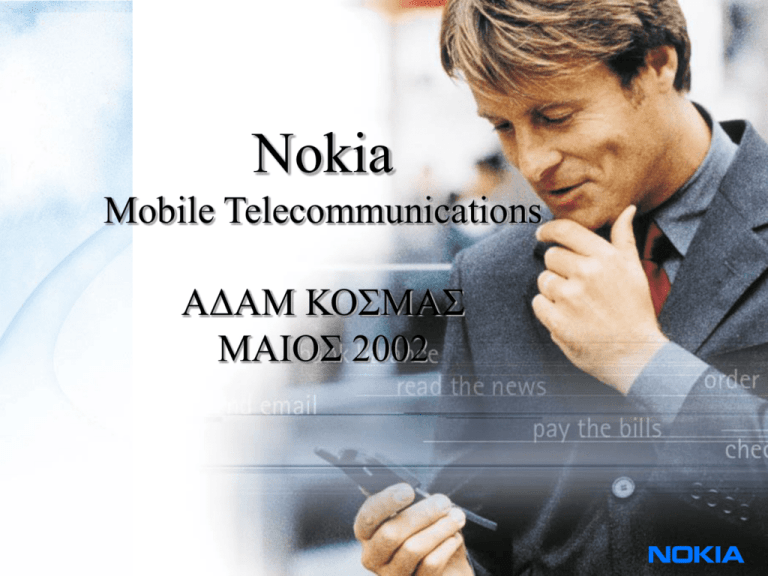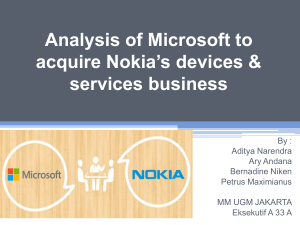Back ground 1
advertisement

Nokia Mobile Telecommunications ΑΔΑΜ ΚΟΣΜΑΣ ΜΑΙΟΣ 2002 STRATEGY DESIGN • • • • VISION/STRATEGIC INTENT INTERNAL ANALYSIS EXTERNAL ANALYSIS IMPLEMENTATION RELATED DIVERSIFICATION(1) • OLD CORPORATE STRATEGY – GRADUAL CHANGE OF PRODUCTION LINE TO RELATIVE BRANCHES • OLD PRODUCTION LINE – CABLES PAPER WOOD – CABLE FACTORY DIVERSIFICATION TO ELECTRONICS – ‘90s FOCUS IN TELECOM RELATED DIVERSIFICATION(2) • Old branch were profitable • Diversification relied on old branches profits • Trial and error procedure – Electronic branch became profitable in ‘80s – Focus on telecom due to low profits of electronic branch. RELATED DIVERSIFICATION(3) • In 90s Nokia withdraws from paper and cable production • Inter-organisational co-operations • Acquisitions(domestic market firstly) RELATED DIVERSIFICATION(4) • Two strange key factors of success – public telecom operator – NMT • Big and advanced market • Offered business opportunities • Head start for competitors Nokia • A leading end-to-end infrastructure supplier • World's largest manufacturer of mobile phones • More than 55 000 employees • Netsales USD 20 billion 1999 • Market capitalization value over USD 200 billion 7 © NOKIA TABD.PPT /15.9.1999/VS Nokia Worldwide Sales offices R&D Production, incl. joint ventures NOKIA GROUP BRANCHES • NOKIA MOBILE PHONES •NOKIA TELECOMMUNICATIONS •NOKIA VENTURE STRATEGIC VISION • VISION’S DESCRIPTION IS SORT – “CONNECTING PEOPLE” Customer Analysis • 18-29 years of age • Mainstream product • 2 segments; Consumer/Business Consumer Segment • Light Users • Medium Users • Heavy Users Buying Behavior • Light/Medium users – Price – Low information search – Package deals • Heavy users – Functional & Psychological reasons – High information search Business Segment • Functional motive – Battery life, capabilities, etc. • Buyers; Company or individual employees – Criteria • Employees; capabilities, brand • Company; price, capabilities, provider deals Competitors Analysis • Asian Region • European Region • American Region Market Analysis •275 millions of phones sold in 1999 •Nokia’s share - 79 million units •93% increase from 1998 •50% more than in 1998 The Market is Changing Mobile vs. Fixed Subscribers (worldwide) 2500 2000 Mobile Fixed Data vs. Voice Traffic 1500 (worldwide) Data Voice 1000 500 0 1985 1988 1991 1994 1997 2000 2003 2006 1985 1988 1991 1994 Sources : Nokia, ITU, Dataquest, EMC, Global Mobile 1997 2000 2003 2006 Internet Connectivity Outlook Millions 1,400 1,200 1,000 800 More handsets connected to the Internet than PC's by end of 2003 ! Projected 1 billion Mobile Subscribers Projected PC's Connected to the internet 600 400 200 0 Projected WAP Handsets 1996 1997 1998 1999 2000 2001 2002 2003 2004 2005 From NMT to 3G Socio - Cultural • Unspoken Code of Conduct - Using phones in public venues. • Fashion Statement - Phones have become an accessory Political - Legal • Medical device interference. • Health problems - memory loss, brain cancer. • Dangerous while operating a vehicle SWOT Analysis • Strengths – Strong Organization – Great brand name recognition – One of best innovators in the Industry – Sets tone for the entire market technologically • Weaknesses – Large Organization – Different market operations • Control • Currency risks SWOT Analysis • Opportunities – New Markets – Internet • Threats – Risk – Changing Technology – Increased competition • Asia • Europe • USA BCG Matrix 60% 50% - Stars 45% - Question Marks 40% 35% 30% 25% 20% 15% - Cash Cows Dogs 10% 5%0 10X 5X 1X 0.5X 0.1X Pricing • 2 segments and systems • Cellular network providers – Selling high quantities in bulk – To price sensitive market • Individuals needing top line products – Not price sensitive – Newest technology – Newest design Product • 18 new models in 1999 New demand driven • applications • services • devices and • design Promotion • Consumer segment – – – – Mass media; TV/papers/magazines Co-op advertising Internet Sports events • Snowboarding World Cup • Adventure Sports – Boat/balloons Promotion • Business Segment – Sales agents – Promotion targeted towards consumers Product-Market Expansion Strategy • Currently in 130 different markets • Joint ventures/distributor agreements • Continue to expand as long as need and buying power exists. • Expansion of GSM and 3G network. – China, UK, Philippines, Norway, Turkey Europe is still leading the way…. 450 000 Forrester Predicts That One in Three Europeans Will Access the Net Via Population Mobile Phone by 2004 400 000 350 000 Mobile subscribers 250 000 Source: Forrester Research, Inc., 1999 04 20 02 03 20 19 99 0 20 50 000 01 100 000 20 150 000 AMSTERDAM, Netherlands--(BUSINESS WIRE) via NewsEdge Net-enabled Corporation --Europe stands on the brink of a revolution in Internet access. By 2004, one-third of all Europeans -- more than 219 million consumersmobile -phone will regularly use their mobile phones to access Internet services according to owners a new Report from Forrester Research B.V. (Nasdaq:FORR). Although the sites that will host these services are already being built, it remains unclear Regular mobile whether mobile operators will provide free and open access to these sites. Internet users* Europeans lead the world in mobile phone use, with more than 117 million people in the EU carrying mobile phones. Many of these phones are already being used for data -- Europeans pass more than 2 billion short message service (SMS) messages a month to chat and read sports scores. These two factors, plus the introduction of wireless application protocol (WAP) phones, will vault Europe into the lead for mobile Internet access. (continues….) dated: 1999-12-16 00 200 000 20 '000 300 000 Differentiation Diversification Information Entertainment WAP Development Voice e-mail Video e-shopping and banking Concentrate on youth • Finnish teenagers send on average 100 messages per month • Up to 90%, on average 50% of the bill is SMS • Teenager bill '97 was $20 • Teenager bill '98 was $40-$50 WE HAVE ONLY SEEN THE BEGINNING Thank you


